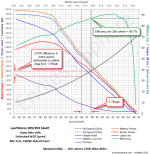I know this is disappointing to yall.. but I do not have a temp sensor, guys..
The motor is lightly vented on both sides.. i take these measurements by pointing a little turnigy temp sensor at the coils through a vent hole. I double checked to see if the temp sensor was off.. it is unfortunately not off..

I have been periodically checking the motor at stops this way since i've vented it. Before, i would take the hottest point on the case and then figure the math on the internal temps based on justin at ebikes.ca's tests for the 9C here:
http://endless-sphere.com/forums/viewtopic.php?f=2&t=48753
When i see ~200C at the coil, the hub case is not so hot that i can't hold my hand on it. But i can feel heat coming out of it during a rest. I understand that this is too high of a temperature for the magnets, for sure.
I understand entirely that i am pushing this motor very hard. This is still a great motor, however my needs in this area are very, very demanding. It's not only continuous 45mph that i put this motor through, it's also that there is not a single piece of flat land where i live.. it's a constant 0-7% grade rollercoaster.
I would run this motor indefinitely if we had lower speed limits. You can't ask for a more efficient motor with such a low weight.. it hits peak efficiency at around 30mph cruising, which is PERFECT for an ebike in my opinion.
But I am going to upgrade to a MXUS 3kW to give me more headroom. This motor is surely damaged ( demagnetized ), and any future performance observations or numbers are going to be misleadingly poor.
I officially hand off the 'doing science' aspect of this motor to you guys.







